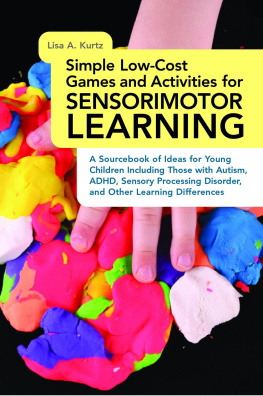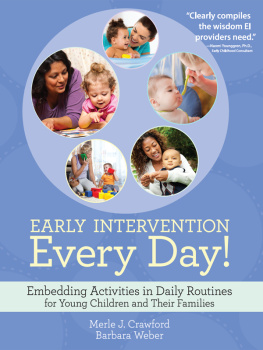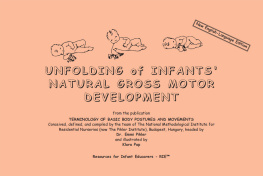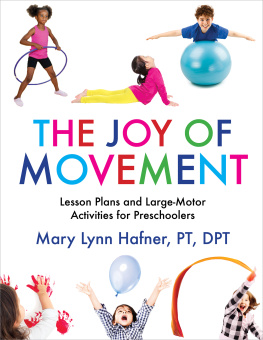Adaptive
Fitness & Gross Motor
Development
A gross motor skills and athletic development guide
Step-by-step instructions of my methods of working
with children with disabilities, which you will understand
and be able to apply on day one!
Ricardo A. Cunningham
Copyright 2015 by S&R Capital Holding LLC
www.lifechangingfitness.org
www.ricardoacunningham.com
Library of Congress Control Number: 2015904573
ISBN: Hardcover 978-1-5035-5541-9
Softcover 978-1-5035-5543-3
eBook 978-1-5035-5542-6
All rights reserved. No part of this book may be reproduced or transmitted in any form or by any means, electronic or mechanical, including photocopying, recording, or by any information storage and retrieval system, without permission in writing from the copyright owner.
Any people depicted in stock imagery provided by Thinkstock are models, and such images are being used for illustrative purposes only.
Certain stock imagery Thinkstock.
Rev. date: 04/10/2015
Xlibris
1-888-795-4274
www.Xlibris.com
709331
TABLE OF CONTENTS
An increasing majority of children with varying levels of disabilities including: Autism Spectrum Disorders, Aspergers, ADD, ADHD, Down syndrome, intellectual disabilities and behavior disorders, as well as with typically developing children with varying skill levels exhibit challenges such as motor delays, coordination, self-esteem and weight management issues. These challenges make it difficult for children to just be children and participate in group activities with their peers. Early intervention is critical when dealing with such issues.
Children with disabilities speak the same language regardless of their nationality, ethnicity, or heritage; but they speak many dialects. To understand one child does not mean you understand another, it simply means you are closer to learning the multiple dialects that exist among children with disabilities. I have spent over thirteen years working with children with disabilities; and in that time I have mastered hundreds of dialects, allowing me to help children make life-changing transformations in their physical abilities.
In 2011 I founded my company, Life Changing Fitness LLC, and it has been my mission to create an environment for learning, developing social and physical skills, and enhancing creativity through personalized training programs. Our programs are customized for each child and have proven to improve their gross motor skills and athletic ability far beyond what was imaginable. Our success comes from connecting with the child, understanding the childs dialect, strengths, and weaknesses, and knowing their limits.
Parents always ask me, Ricardo, how do I get my child to be motivated to do the same activities at home? I cant get them to do half the things they do in gym. Some have even called me the Autism Whisperer. There is a simple answer to this question: each child learns differently, therefore you first need to determine the childs learning style. The child may be a visual learner, auditory learner or a kinesthetic learner. Once you know the proper learning style to apply, you will begin to learn the childs dialect and it will be easier to motivate the child to do activities at home.
Another common question I get from parents is, What can I do at home with my child, since we cant come to the gym every day? We all know that children retain what they learn better through repetition, so, for a child with a disability, there needs to be more repetition to acquire skills in their activities. This book is designed to be a self-help book for parents, and anyone working with a child with a disability. This book can be used as a guide to the different types of activities, and their proper execution techniques, to help children with gross motor delays and also those needing to improve their athletic ability. The activities described will improve childrens motor planning, motor processing, balance, visual-spatial awareness, coordination, hand-eye coordination, cardiovascular endurance, and strength.
My techniques have proved to be successful time and time again with children of varying profiles. Using some basic athletic equipment coupled with this book every day, you will be able to duplicate a gym experience. Your child will be engaged, learn fundamental skills, and also have fun playing with their family and peers. For adaptive fitness professionals, this book is an excellent resource and guide for the proper execution techniques to be used when working with a child with disability. The book provides detailed descriptions of how to perform each activity, as well as depictions of the activities with visual cues.
The first step in working with a child with special needs is to know what you need to work on. It makes no sense to start working blindly with a child with no concept of what the child needs to improve on. Every child has their strengths and their weaknesses. You, the parent, should have your child assessed by a professional in the field to determine what you should be working on. You, the professional, should always complete an assessment of the child before you begin working with the child. It allows you to focus on what they need to improve on. It allows you to use the childs strengths to build their self-confidence, and to tailor a program that will turn those weaknesses into strengths.
Once you have assessed the child, you now know what your goals are. Set goals with the child so they have something to look forward to. You are now ready to begin the hard work. I say hard work because thats what it is. And with hard work there are great rewards. When you see your child achieve their first goal, it will be the best feeling for you and the absolute greatest accomplishment for your child. And it only gets better as the child continues to accomplish their goals.
Throughout the book I recommend that you perform three sets of ten repetitions for each activity. This means performing the activity ten times, taking a break, and performing another set of ten repetitions of that activity. Parents can increase the repetition or set for each activity based on the childs ability to focus. If your child gets frustrated or seems tired after the three sets of recommended repetitions, you should avoid increasing the repetitions during that session and add another day instead. If your child has the focus to continue after the three sets of recommended repetitions then you can add another set during that session.
In the next chapter I will discuss the different learning styles of children.
Chapter 1
LEARNING STYLES
To learn we depend on our senses to process the information around us. The three main learning styles are visual, auditory and kinesthetic. Everyone has one learning style that may be more effective than the others. It is very important to apply the right style of learning when teaching children with special needs, especially in a one-on-one setting. When you apply the style of learning that best suits the child, the child will be more motivated because they are able to process the information faster. And they are able to absorb the material easier. Applying the right style will also build their confidence and self-esteem.
A visual learner is someone that learns best by seeing how something is done. They are able to retain the information and repeat what was demonstrated.
An auditory learner is someone that learns best by listening to directions and instructions given to them.
A kinesthetic learner is someone that learns best through hands-on experience. The instructor needs to hold their hands and take them through the motion of the activity.
As a parent or professional, it is important that you know the three main types of learning styles and how to apply them when teaching the child. When you begin working with the child you should apply all three styles of learning to see which style works best. Once you know which style best fits the child, you should use that as your primary technique of teaching the child.
Next page







